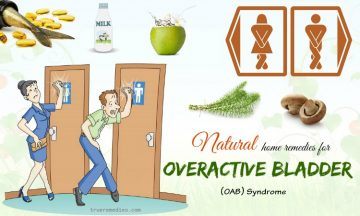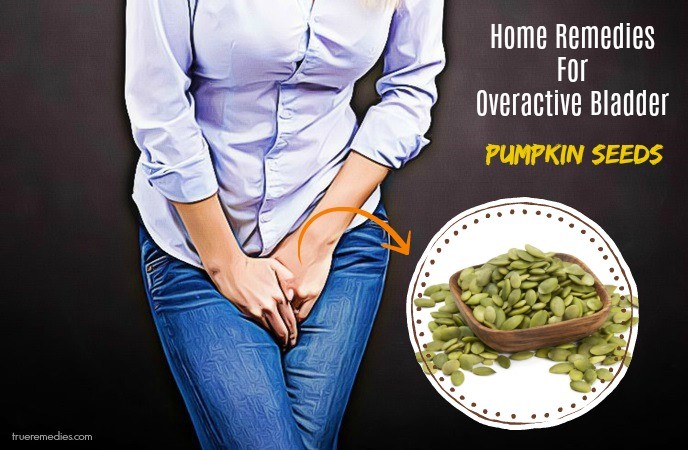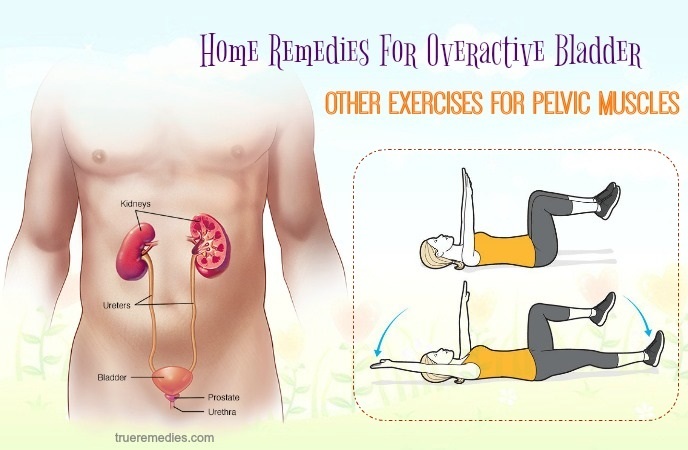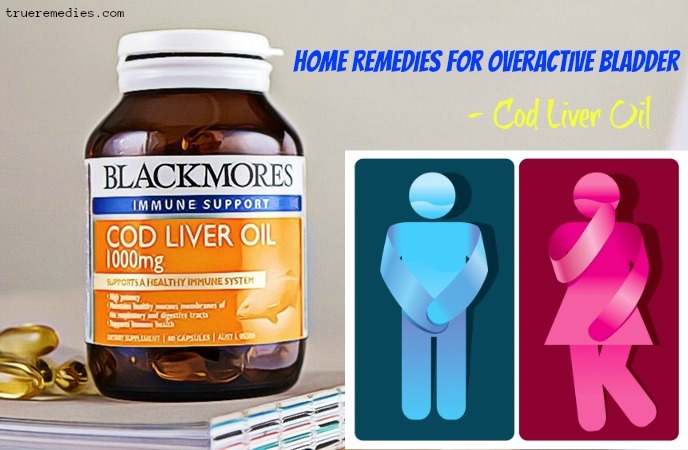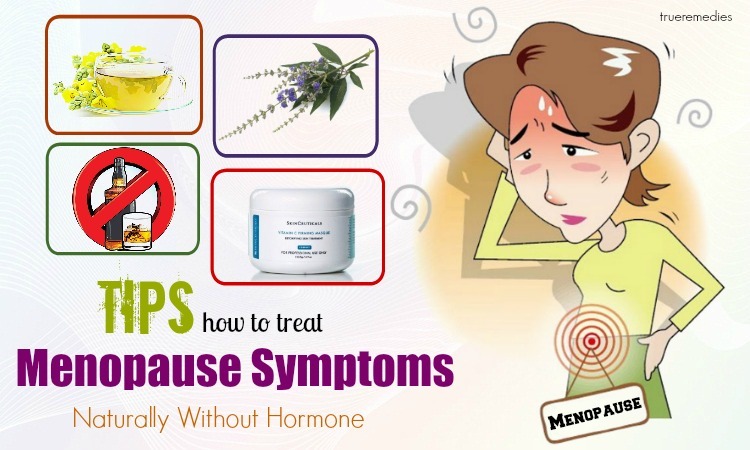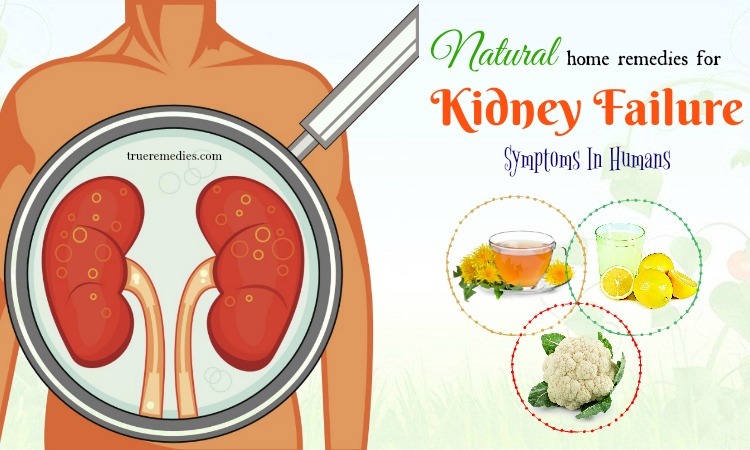updated: 11/09/2019
Contents
Overactive bladder (OAB) is not a disease but a syndrome – a set of symptoms. It is very easy for urinary retention, and can make the urine uncontrollably. This disease is not dangerous, but it will affect the course of action as well as the relationship of the patient. In regard to OAB, many people get and suffer from it in silence. It is estimated that at least 33 million populations in America have this condition [1]. Actually, many of you are wondering that: how much is too much regarding urination? In reality, people having OAB have to urinate more than 8 times each day or more than once per night [2].
I know that the reason you are reading this article of 10 Natural Home Remedies For Overactive Bladder is to learn how to treat overactive bladder the natural ways, but before that, you had better understand some basic information about this problem. It is important to address OAB symptoms right instantly and early treatment could timely reduce, or completely remove the unwanted symptoms. Hence, you can deal with it the right way.
What Is Overactive Bladder?
Overactive bladder (OAB) problems are related to the reserve function of the bladder, causing sudden urge to urinate. Then, the bladder muscles develop contractions with greater frequency and make you want to urinate [3]. That leads to difficulty controlling your cottage.
Urinary system includes:
- Two kidneys;
- Two ureters (tubes that connect the kidney to the bladder);
- Bladder;
- Urethra (tube that carries urine from the bladder out of the body).
The muscles also participate in the process of urinating, which leads to abnormalities in many different organs. Bladder, kidney or bladder obstruction and muscle problems can cause the bladder to overactive.
TrueRemedies Partner Solutions

Need a Help from the Leading Expert Online, Available 24/7?
They’re all here and ready to answer your questions online or by phone. Keep asking questions until you get the answer you need.
There are two different types of overactive bladder. The “dry” type is when you have an urgent, sudden need to urinate a lot of times during the day. The “wet” type is when you have urgent, sudden need to urinate and you go through bladder leakage, which is referred to as urge incontinence.
Both of these types could happen without underlying health issue [4].
What Are Common Causes Of Overactive Bladder?
OAB happens in both men and women and you can suffer from it at any point in your life. However, this condition seems to be common in older adults [5].
Overactive bladder is usually caused by the underlying causes:
- The normal urination process requires the integrity of the nervous system, such as the central nervous system with the sympathetic nervous system, the detrusor muscle and the urethra. When these organisms are injured it will result in urinary output disorders from the bladder. If the nervous system controls the urination get hurt, the entire process of urination is affected. If part of the central nervous system is damaged, including the temporal lobes and spinal cord, it causes urinary dysfunction such as acute urinary retention and overactive bladder. If the peripheral nerves that are involved in the bladder are injured, the soft muscles in both the bladder and the urethral sphincters will cause continuous bedwetting.
- Uncontrolled urination can be due to the cause of bladder dysfunction or urethral sphincter. The increased activity of the bladder (overactive bladder) usually presents with symptoms of an unstable, uncontrolled urinary retention. A combination of increased bladder and silent inactivation may result in mixed symptoms of overactive bladder.
- Neurological disorders in Parkinson's disease, stroke, fibromyalgia, traumatic spinal cord injury, diabetes …
- Abnormalities in the bladder, such as tumors or bladder stones.
- Factors that interfere with flow from the bladder such as prostate tumors or the effects of treatment on the sub-framework.
- Drink too much caffeine. This is a stimulant and a diuretic, meaning that your bladder works more actively and your bladder produces more urine. Therefore, it is best to minimize or even avoid caffeine. Switch to eating chocolate that contains less caffeine, such as white chocolate.
- Drink too much wine. Alcohol stimulates the bladder and inhibits motor movement, making control harder. In addition, alcohol also dehydrates the body, causing the bladder to become irritated.
- Citrus Fruits: Citric acid in fruit and citrus juice can cause bladder irritation.
- Some processed foods also have a special effect on the overactive bladder. Preservatives and artificial additives can cause bladder irritation and make the symptoms worse.
- Spices can also make the bladder uncomfortable. Spices such as mustard, soy sauce, tomato sauce and vinegar may contain acid or other stimulants.
- Some cases cannot be identified.
- Urinary tract infections can cause symptoms very similar to overactive bladder.
- Menopause: women often go through changes in bladder after their bodies experience menopause. Therefore, OAB is more likely to occur. Some people say that a loss of estrogen is the culprit of this problem while others say that it is just because of aging or a combination of two.
- Obesity or extra weight: Having extra pounds in your waistline is connected to urine leaks and OAB because excess weight puts more pressure on bladders.
What Are Symptoms Of Overactive Bladder?
Signs and symptoms of overactive bladder could include the following:
- Sudden urge to urinate.
- Difficult to control urination such as difficulty not urinating, urinary incontinence.
- Urinate several times a day, usually eight or more times in 24 hours.
- 2 or more than 2 times that you urinate during the night (nocturia).
- In severe cases, the patient can have intermittent bedwetting (enuresis)
- Urinary incontinence but not cause hurt for the patient if there is no underlying urinary tract infection. The amount of urine in the day is not too much (no polyuria).
How Does Overactive Bladder Affect The Patient?
- Overactive bladder can affect the quality of life of the patient, causing them to feel shame and impede much in living and working.
- People who have increased bladder activity are more likely to suffer from depression.
- Sleep disturbances and sleep cycles are interrupted.
- Some people do not control the urine, especially when stress, coughing, sneezing, laughing.
- Patients susceptible to urinary tract infections.
Who Is At Risk Of Overactive Bladder?
This condition is very common and can affect patients of all ages. However, you can control it by minimizing risk factors. As you get older, you are at risk for overactive bladder. You also have high risk for diseases and disorders such as prostatic hypertrophy and diabetes, which contribute to other problems related to bladder function.
Many people who experience cognitive impairment, for example after a stroke or Alzheimer's, are also at increased risk of overactive bladder. The uncontrolled bladder from such situations can be controlled with punctual urination, diaper and bowel control programs. Some people with overactive bladder also have problems with bowel control. You should talk to your doctor if you have any of these problems.
When To See A Doctor?
Early diagnosis and treatment can prevent this condition from getting worse and avoid emergency situations. Therefore, you should see your doctor as soon as possible to avoid this condition. If you have any of these signs or symptoms or have any questions, please consult your doctor.
There, you have discovered some information about periodontal, it is time to find out what the best natural home remedies for periodontal are. Take a look at TrueRemedies.com!
Top 20 Natural Home Remedies For Overactive Bladder
1. Pumpkin Seeds
This is the first home remedy for overactive bladder for you to do at home. Pumpkin seeds contain tryptophan, insoluble fatty acids, and high levels of antioxidants, which provide many benefits to the body. Thanks to the high levels of carotenoids and liposolunols, pumpkin seed oil is considered as an ingredient to help prevent diseases, especially prostatic disease.
In addition, scientists have demonstrated its effectiveness in treating diabetes, anxiety and overactive bladder. A study published in the Journal of Traditional and Complementary Medicine found that pumpkin seed helped improve urinary symptoms in study participants after 12 weeks of supplementation. Pumpkin seeds contain a lot of fatty acids and phytoesterol which are essential for the bladder, especially for women after menopause.
Method 1: Only Pumpkin Seed
To implement this method, please follow these steps below:
- Prepare 10 grams pumpkin seeds.
- Rinse the pumpkin seeds, then roast for 3 minutes so that the pumpkin seeds ripen.
- Peel pumpkin seeds and eat during the day when you feel hungry.
Method 2: Pumpkin Seed And Water
To implement this method, please follow these steps below:
- Prepare 20 grams pumpkin seeds, 500 ml boiling water.
- Rinse pumpkin seeds, then use the pumpkin seeds to soak in boiling water and leave for 30 minutes.
- Filter for the juice and drink it.
You can implement this method 4-5 times a week for best results.
Method 3: Pumpkin Seed, Sugar And Honey
To implement this method, please follow these steps below:
- Prepare 100 grams pumpkin seeds, 2 tablespoons sugar, 2 tablespoons honey.
- Rinse the pumpkin seeds, remove the shell of pumpkin seeds to leave the green layer inside.
- Grind the pumpkin seed by the grinder and mix with sugar and honey.
Stir well and eat them when you feel hungry.
2. Kegel Exercises
Among home remedies for overactive bladder, Kegel exercises are one of the most effective. The Kegel exercise was proposed by a gynecologist named Arnold Kegel Henry in 1948. This is a muscular exercise for the pelvic floor – the genital area. Kegel exercises help to activate pelvic floor muscles and strengthen the muscles of the anal and sphincter of both women and men [6].
Method 1: Kegel Exercises For Women
You can practice in the following positions:
- Sit: Sit in a chair, straight back, knee slightly turn out, or you can stretch your legs forward.
- Lying: Lying on your back, knees bent, feet turn out.
- Stand: Stand upright, cling to the chair, slightly arched knee, broad shoulders, feet and toes slightly spaced outward.
To implement this method, please follow these steps below:
Level 1: Control Urinating
Keep your vaginal contractions and then relax as if you are urinating and then stopping in the middle. Repeat this procedure repeatedly for 10-20 minutes, at least twice a day for the best results. During the exercise, you should remember not to cause an effect on muscles of abdominal, legs, back and buttocks (after exercise, you feel tired of these muscles, it means that you do not do the exercise properly). You can place your hands on your belly while exercising. When exercising, you must take slow and have deep breaths.
Level 2: Practice With Your Finger
Wash your hands before practicing the exercise. Insert your finger into your vagina and try to contract your vaginal muscles to tighten your finger. Then, you will feel the vagina shrink.
Level 3: Vaginal Tightening
- Vaginal tightening for 5 seconds and rest for 1-2 seconds.
- Tighten your vaginal muscle a little more, count to 5 and rest for 2-3 seconds.
- Tighten as much as possible, count to 5 and rest for 2 seconds.
- Loosen each one, each level to 5.
Level 4: Repeat Several Times
- Once you have achieved the results of the above levels, you should work on the harder level as follows:
- Vaginal muscle contraction 3 seconds, relax. Repeat 10 times.
- Tighten and relax as quickly as possible. Repeat 25 times.
- Imagine you are trying to suck something into your vagina. Hold it for 3 seconds, relax. Repeat 10 times.
- Imagine you are trying to push something out of your vagina, hold for 3 seconds, then relax. Repeat 10 times.
Method 2: Kegel Exercise For Man
To implement this method, please follow these steps below:
Level 1
- Tightening and releasing the anal muscles is like trying to hold back, done in 10 seconds. Repeat 3 times, Break 10 seconds each time.
- Tighten and release the anal muscles within 5 seconds. Repeat 5 times, break 5 seconds each time.
- Tighten and release the anal muscles within 30 seconds. Repeat 3 times, break 30 seconds each time.
Level 2
- Tighten and hold the anal muscles for 5 seconds, then relax. Do it again 10 times.
- Quickly tighten tight anal sphincter and release 10 times. Repeat it 3 times.
- Tighten and release the anal sphincter while counting from 1 to 10.
- Tighten the anal sphincter firmly and keep it as long as possible. It is best to keep it within 2 minutes.
Level 3
- Tighten tight and release the anal muscles continuously for about 30 times.
- Tighten and keep the anal sphincter to the extent possible, hold for 20 seconds. Repeat 5 times, between every 30 seconds.
Level 4
Tighten and release anal muscles 2 minutes every day. Repeat this exercise with an arbitrary number time.
3. Other Exercises For Pelvic Muscles
This is another must-try home treatment in this list of home remedies for overactive bladder. In addition to Kegel exercises, you can do the following 5 exercises to improve the health of the pelvic floor muscles.
Method 1: Push Up Exercise
To implement this method, please follow these steps below:
- Lie to let the face down to the ground then lift your body up to form a push-up.
- Straight arms and straight shoulders. Neck, hips and legs form a straight line, avoiding the hips to touch beneath the floor.
- Tighten abdominal muscles. Hold this position for 30 seconds to a minute. Repeat 2-3 times.
Method 2: Hips With Figure No. 8
To implement this method, please follow these steps below:
- Lie on your back, spread your hips wide and straight on the floor.
- Raise the hips off the floor, holding the shoulders close to the ground to make the posture as a bridge.
- Then use the hips to draw a figure of 8 in the air. Lower the body by lowering the spine to the floor.
- Repeat 2-3 times, 8 beats each time.
Method 3: Lift Your Leg
To implement this method, please follow these steps below:
- Lie on your back, straighten your legs together, knit two arms together and place them under your back.
- Lift your feet off the floor, pausing.
- Then raise your feet up again until they form a square with the hips and hold for a few seconds, then return to the original posture.
- Repeat 2-3 times, each time 10 beats.
Method 4: 4-Legged Action
To implement this method, please follow these steps below:
- Lie with your face look to the ground.
- Raise two hands to the ground so that your wrist straight below your shoulders and kneel on your knees.
- Put your right hand forward while your left leg stretches outwards.
- Bring both hands and feet to the original position, then repeat with the left and right legs.
- Continue alternating hands and feet while keeping your abdominal muscles tight and trying not to move the trunk.
- Do this twice, every 10-12 spans each.
Method 5: Squats
The way to implement this method is very simple, you only need to implement squats exercise for your best treatment of overactive bladder.
4. Horsetail (Equisetum)
Horsetail or equisetum is very effective in the treatment of the overactive bladder. Horsetail has antispasmodic, antibacterial properties that help prevent urinary tract infections. Therefore you can use horsetail to cure overactive bladder. The use of horsetail can reduce thiamin levels, so you must drink plenty of water. Horsetail contains nicotine, so you do not use horsehair for babies.
The way to implement this remedy is very simple, you only need to drink 1-2 teaspoons of equisetum a day, 4-5 days a week for the best treatment.
5. Mushroom
This remedy is one of little – known home remedies for overactive bladder. Mushroom contains fewer calories. This is a popular dish thanks to the taste, shape and large amounts of nutrients, especially vitamin D. Mushroom has the potential to lower blood pressure, help with weight loss, control migraines, and maintain metabolism. Therefore, it works very well in the treatment of overactive bladder.
Method 1: Only Mushroom
To implement this method, please follow these steps below:
- Prepare 2-3 mushrooms.
- Rinse the mushrooms. Grind it by the grinder then steam the mushroom in water for 30 minutes.
Use the mixture above to eat at night before going to bed
Method 2: Mushroom And Wine
Alcohol is the cause of overactive bladder but using alcohol properly will help relieve symptoms of overactive bladder quickly.
To implement this method, please follow these steps below:
- Prepare 2-3 mushrooms, 3 teaspoons of wine.
- Rinse the mushrooms. Grind it by the grinder and mix it with wine.
- Steam the mushroom for 30 minutes.
Use the mixture above to eat at night before going to bed.
6. Milk
The next treatment in this list of home remedies for overactive bladder is milk. Milk is considered one of the best sources of vitamin D. A glass of milk contains a lot of nutrients necessary for the body. Researchers point out that vitamin D in milk is anti-aging. In addition, high levels of vitamin D may reduce the risk of pelvic dysfunction, particularly in women with overactive bladder syndrome. A study published in the European Journal of Clinical Nutrition also found that low levels of vitamin D affect bladder outgrowth in older patients.
The way to implement this remedy is very simple, you only need to drink 2-3 cups of milk a day. Drink milk every day in a week for the best effect.
7. Cod Liver Oil
Cod liver oil is widely known as a source of large amounts of vitamin D. This fish oil has the potential to improve the condition of the heart and cardiovascular system. In addition, it assists in strengthening the muscles' activity and elasticity of blood vessels. Studies have shown that fish liver oil helps to reduce high cholesterol levels in the blood and to thin the blood, thereby reducing the risk of arterial obstruction. Using fish oil as a treatment for overactive bladder will give high efficiency and safety.
To implement this remedy as a treatment of overactive bladder, you only need to drink 4-5 ml of cod liver oil in a day, 3-4 days a week for the best effect.
8. Liver
The liver is an excellent source of vitamin D for the body. Although all foods such as cow's liver, chicken liver and calf contain a high content of vitamin D, the Calves liver has the highest vitamin D content. The liver is not only useful for bone growth, but it also helps the skin, healthy hair and promotes cell renewal. The use of liver as a treatment of overactive bladder will provide a large amount of vitamin D, thereby reducing the symptoms of this disease. To implement this remedy, you only need to eat about 400 grams of liver in a week.
9. Coconut Water
The next one in this of home remedies for overactive bladder is coconut. Coconut water is rich in potassium and other minerals so it regulates the internal fluid and replenishes water for the body. Plasma found in coconut water is similar to human blood. Therefore, drinking a glass of coconut water daily will help reduce the risk of gastrointestinal irregularities, and quickly regain the body after dehydration.
If you drink coconut water regularly can reduce the urinary problems. People who have overactive bladder and other urological conditions should drink plenty of coconut water to relieve the symptoms of the disease. The way to implement this remedy as a treatment of overactive bladder is very simple, you only need to drink a cup of coconut water in a day. Dink coconut water every day in a week for the best effect.
10. Capsaicin
Capsaicin is a substance that is abundant in chilies. In accordance with a study in the Journal of the Thai Medical Association, experts can rely on chili compounds to treat disorders in the bladder. This is an effective and virtually inexpensive option. You only need to eat one chili a day during the week as a treatment of overactive bladder.
11. Avoid Dietary Triggers
To take control of your overactive bladder symptoms, it is vital to avoid dietary triggers. You need to reduce the foods and drinks below which are known to contribute to this condition [7]:
- Caffeinated drinks and foods
- Fruits and citrus juices
- Alcohol
- Spicy foods
- Soda and other carbonated beverages
- Artificial sweeteners
- Sugar and high-sugar foods
- Milk products
Alcohol, caffeine and certain medications like diuretics are claimed to be the main causes of acute incontinence, particularly in the old [8].
Besides, you need to watch your fluid intake to avoid dehydration. Nonetheless, if you drink too much before bedtime, you will be prone to empty your bladder. A large number of OAB sufferers have nocturia – the demand to urinate a few times per night. Obviously, this is highly disruptive to having a good night’s sleep.
12. Delay Urination
Another tip of an effective bladder training technique is delaying urination. It might not be pleasant, but it can hold several minutes after feeling the urinating urge, then you could retrain your own bladder. By steadily increasing your holding time, you could finally go at least 3-4 hours without needing to go to the toilet. Also, try to stick to scheduled urinating time [9]. Also, do not underestimate the efficiency of relaxation techniques like deep breathing to make your delay time much more bearable.
The above-mentioned home remedies for overactive bladder are claimed to be able to reduce the symptoms of heavy or prolonged periods. Hope that these natural tips will help you take back control of your bladder and your own life as well. It is very easy to take some basic aspects of our precious health for granted. So do not skip addressing your OAB symptoms. Keep in mind that early treatment and prevention could decrease or remove unwanted OAB symptoms.
If you are willing and ready to make changes and put in your attempt required for natural treatment, OAB symptoms are within your power to improve, and probably eradicate. Choose some of them and alternate them in your treating to see how effective they are. If you have any contributing ideas about our article of “Top 20 Natural Home Remedies For Overactive Bladder Problems” introduced in Home Remedies Category, do not hesitate to drop your words below this post. We will answer as soon as we could.


